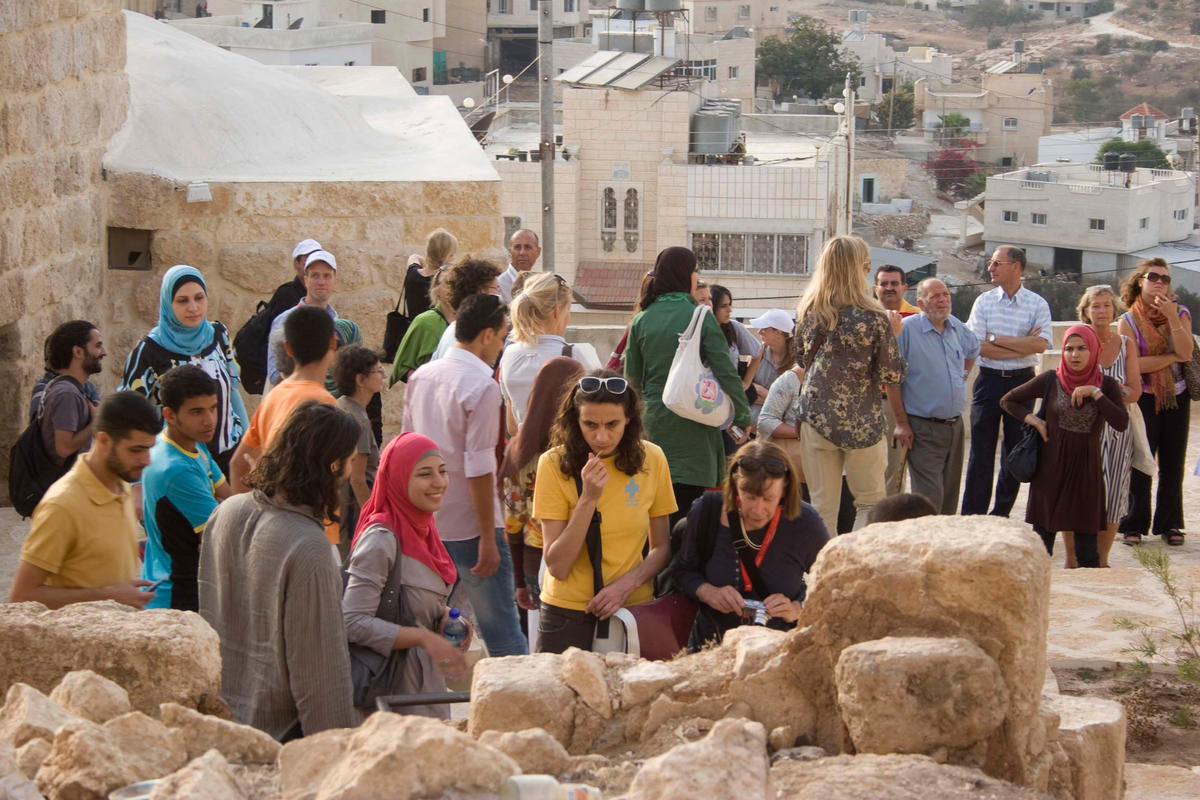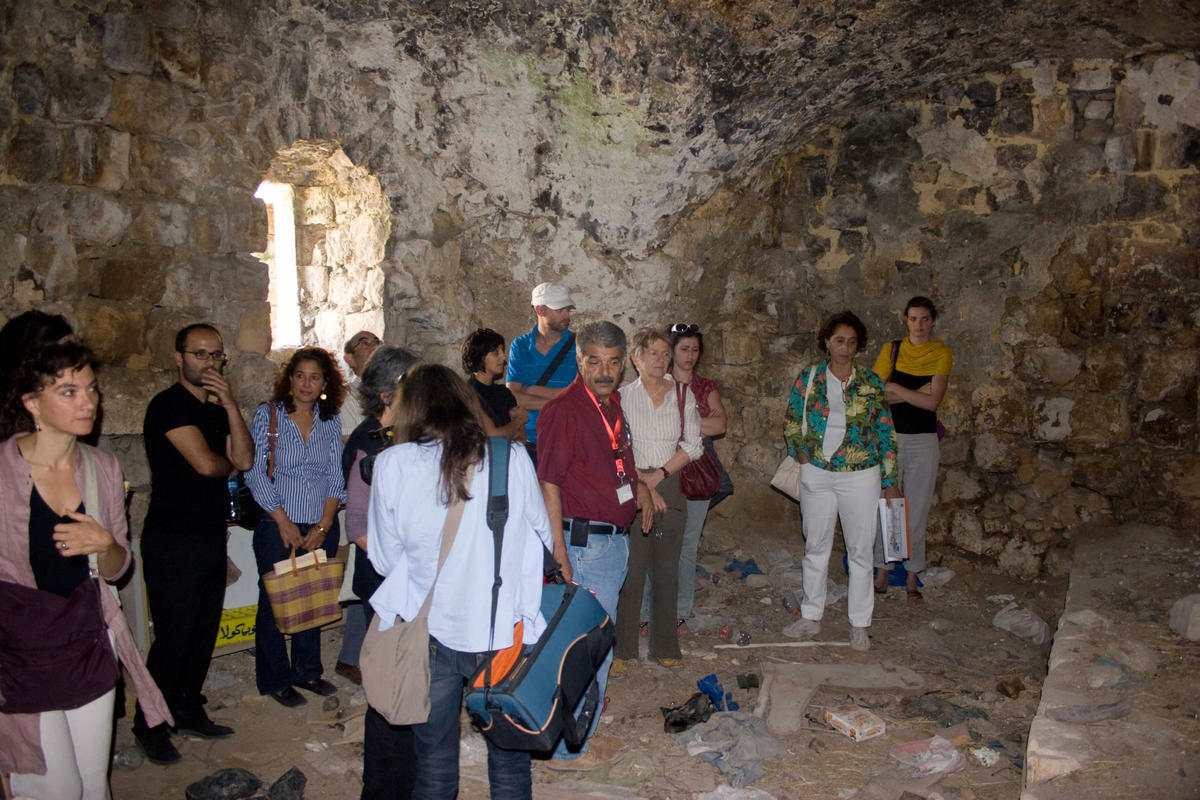
Palestine
3rd Riwaq Biennale
Various venues
June 3–October 16, 2009
The 3rd Riwaq Biennale organized itself around a question: Can a biennial be a biennial in a state that’s not a state? In addressing that question, curators Reem Fadda and Charles Esche assembled the biennial in the form of tours, curated conversations, and temporary interventions distributed between disparate locations in Palestine. This was the second act of a “dual presentation”; the first half was staged by director and founder Khalil Rabah as a biennial-cum-artwork in the exhibition ‘Palestine c/o Venice,’ a “collateral event” of the 53rd Venice Biennale.
Following in the tradition of Rabah’s earlier conceptual works — The New Palestinian Museum of Natural History and Humankind among them — the Riwaq Biennale posed as an institution engaged in the elaboration of national narratives, and as such, it negotiated the space between fact and fiction. Named for the NGO Riwaq, the biennial aligns itself, in each iteration, with the aims of that organization, which seeks to promote and preserve Palestinian cultural heritage. Though this year’s biennial itself didn’t extend to the geography of the titular fifty villages, it sought to draw attention to the range of historic sites on the NGO’s register.
As a self-proclaimed “journey between locations,” the biennial sought to fracture the spectacular through the fragmented physical and cultural landscape of Palestine. In view of the local political condition, the event eschewed monumental displays. Instead, the tour itself often served as the main event: the trails of this biennial followed the trajectories of the curatorial framework, often looping back, creating fissures where participants might encounter themselves as consumers, critics, creators, and captives of sometimes competing cultural narratives. In an area already overdetermined by ideologically driven tours, the Riwaq Biennale seemed troubled by, and called attention to, the limits of rhetoric. In a region that’s so resource-poor, event organizers questioned, of what value is pure theory? Their efforts, rhetorical and otherwise, to create a framework for sustainable cultural engagement married the two Riwaqs: the NGO’s mission of historic conservation and the biennial’s efforts at cultivating a contemporary cultural preserve. By generating the conditions for new artworks to be made and stay in the territories, organizers hoped to invest in a new generation of cultural capital.

In this iteration of the biennial, the tours of villages centered on Riwaq’s conservation projects. A sense of the urgency of Riwaq’s operation was especially manifest during a trip to the town of Sabastiya, with its Roman ruins and presumed tomb of John the Baptist. Asphalt was recently laid down atop the Roman road there, and the sides of the bus I was on nearly grazed what columns remained standing on either side. Sabastiya is one of a number of towns under a protection plan put in place by Riwaq. The NGO is working, in the absence of a national policy, for the preservation of cultural and national heritage, and is undertaking efforts to establish the necessary constitutional and legal framework for that.
A Riwaq Biennale tour of Jerusalem intersected with two other art exhibitions: The Other Shadow of the City, and The Jerusalem Show. The biennial-within-a-biennial begat a tour-within-a-tour, as curators Jack Persekian and Nina Möntmann led a guided exploration of the artworks and interventions situated throughout the Old City. Brought together under the title The Jerusalem Syndrome, the exhibition referenced a state of delirium known to overtake tourists to the city — who might, for example, succumb to the illusion they themselves are the Virgin Mary or the Messiah. The Jerusalem Show, like the Riwaq Biennale, ministered to the covert, distributing works throughout the Old City, to be read as moments of resistance. The curators conceived the show itself as a political act that knit together an affiliation of institutions, organizations, cafes, and other operations in the city in recurring armistices.
The majority of art exhibitions included in the Riwaq Biennale’s arsenal of cultural tourism highlighted concurrent productions put on by Palestinian cultural organizations. One tour incorporated Birzeit University’s Ethnographic and Art Museum, which presented 'Jerusalem Our Home,’ one of a series of exhibitions on Palestinian cities planned by the museum, and House No. 197, by Jawad Al Malhi, a photographic panorama of the Shu’fat refugee camp, also included in the 'Palestine c/o Venice’ exhibition.
Presentations of artwork organized for the Riwaq Biennale itself were few in number. A program curated by Nikki Columbus for Cairo’s Townhouse Gallery, a collaborating institution, was a standout. Featuring contemporary videos from Egyptian artists, the screening was projected in an outdoor courtyard in the historic center of Birzeit. The site brought works such as Wael Shawky’s Telematch Shelter — featuring the already “improbable” architecture of a sculptural mud hut imposed on a desert in Western Egypt, with Bedouin children silently entering and exiting — into juxtaposition with the local geography, lending the program’s exploration of place an added resonance.
Occasionally, the event’s stated emphasis on a “quieter register” gave way to an aspect of theatricality. At a tour of a recently renovated community center in Jamma’een, a collection of international and local artists, curators, architects, critics, and biennial guests were greeted by a courtyard of cameras and children outfitted in traditional costume, some bused in from outside villages to entertain them. The performance served to illustrate Riwaq’s mission of cultural preservation, though it threatened to cater to guests’ expectations of an “authentic” experience. Still, the critical engagement of the curatorial framework kept the interaction from defaulting to the maudlin, as the guests were as much witness as cultural consumer.
Three volumes of Riwaq Biennale documentation followed on the event itself, incorporating photographs of the fifty villages, elaborations of recent and past biennial iterations and itineraries, and new contributions from collaborating artists, curators, critics, and institutions. There is a certain paradox built into the entire operation, that this biennial, which explicitly affects a position against the art object, should be claimed as an artwork by its director at the Venice Biennale — in the words of its curators, “leaving room to speculate on its own conception, validity, and continuity.” At the same time, Riwaq appears, perhaps by virtue of its ambivalence, poised to incorporate the future artworks of its participants, as well as collateral cultural productions. It is a well-intentioned mischief, occasioned by a misgiving about more formal platforms for cultural patronage and patriotism.
Whether Riwaq achieves its adopted goals of protecting, utilizing, and promoting cultural heritage in Palestine may take time to fully discern; the grafting of this cutting-edge contemporary art and architecture biennial onto an infrastructure whose principal focus is historic conservation does yield a strategic shifting of art-world attention. The biennial has proven successful at making Riwaq and Ramallah at large a requisite stop on the international circuit of art shows and biennials. Yet while many international biennials are criticized for being little more than tourist attractions, the Riwaq Biennale turned the tour itself into an object of, and tool for, critical reflection.